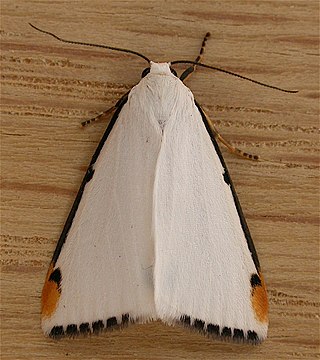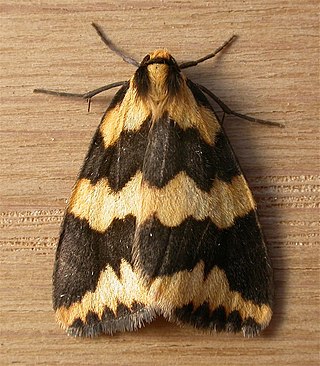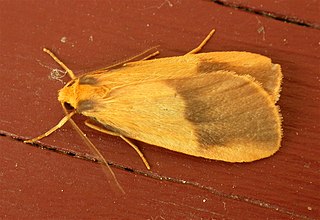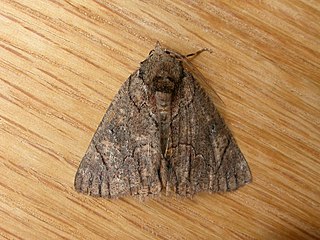
Cybosia is a monotypic moth genus in the subfamily Arctiinae erected by Jacob Hübner in 1819. Its only species, Cybosia mesomella, the four-dotted footman, was first described by Carl Linnaeus in his 1758 10th edition of Systema Naturae.
Parelictis is a monotypic moth genus in the subfamily Arctiinae. Its only species, Parelictis saleuta, the mottled footman, has been recorded from the Australian states of New South Wales and Victoria. Both the genus and species were first described by Edward Meyrick in 1886.
Phaeophlebosia is a monotypic moth genus in the subfamily Arctiinae erected by George Hampson in 1900. Its single species, Phaeophlebosia furcifera, the forked footman, was first described by Francis Walker in 1854. It is found in Australia, where it has been recorded from New South Wales, Victoria, Tasmania and South Australia.

Termessa diplographa is a moth of the subfamily Arctiinae first described by Alfred Jefferis Turner in 1899. It is found in Eastern Australia, often inhabiting forested and open woodlands, as well as heathland habitats. As a lichen moth, the larvae of Termessa diplographa likely feed on lichens that grow on tree trunks.

Termessa nivosa is a moth of the subfamily Arctiinae first described by Francis Walker in 1865. It is found in the Australian states of New South Wales, South Australia and Victoria.

Termessa shepherdi, the shepherd's footman, is a moth of the subfamily Arctiinae. The species was first described by Newman in 1856. It is found in the Australian states of New South Wales, Victoria and Tasmania.

Threnosia heminephes, the halved footman, is a moth of the subfamily Arctiinae first described by Edward Meyrick in 1886. It is found in Australia, where it has been recorded from the Australian Capital Territory, New South Wales and Victoria.

Heliomystis is a monotypic moth genus in the family Geometridae. Its only species, Heliomystis electrica, the electric moth, is found in the southern half of Australia. Both the genus and species were first described by Edward Meyrick in 1888.

Anestia ombrophanes, the clouded footman, is a moth of the subfamily Arctiinae. The species was first described by Edward Meyrick in 1886. It is known from the Australian Capital Territory, New South Wales, Queensland, Western Australia, Victoria and South Australia.
Hesychopa chionora, the white footman, is an Australian moth of the subfamily Arctiinae. It was described by Edward Meyrick in 1886. It lives in Victoria, Queensland and New South Wales.
Damias procrena, the procrena footman, is a moth of the family Erebidae. The species was first described by Edward Meyrick in 1886. It is found in the Australian states of Victoria and Tasmania.
Hectobrocha pentacyma, the five-banded footman, is a moth of the subfamily Arctiinae. It was described by Edward Meyrick in 1886. It is found in the Australian states of Queensland, New South Wales and Victoria.
Scaptesyle dichotoma, the reticulated footman, is a moth in the subfamily Arctiinae. It was described by Edward Meyrick in 1886. It is found in Australia, where it has been recorded from Queensland, New South Wales, and Victoria.
Symmetrodes sciocosma is a moth belonging to the subfamily Arctiinae. It was first described by Edward Meyrick in 1888. This species is native to Australia, specifically found in the Northern Territory, Queensland and New South Wales.
Termessa conographa is a moth in the subfamily Arctiinae. It was described by Edward Meyrick in 1886. It is found in Australia, where it has been recorded from New South Wales and Queensland.
Thallarcha chrysochoa, the golden footman, is a moth in the subfamily Arctiinae. It was described by Edward Meyrick in 1886. It is found in Australia, where it has been recorded from the Australian Capital Territory, New South Wales and Victoria.
Thallarcha oblita, the hidden footman, is a moth in the subfamily Arctiinae. It was described by Rudolf Felder and Alois Friedrich Rogenhofer in 1875. It is found in Australia, where it has been recorded from the Australian Capital Territory, New South Wales and Victoria.
Thallarcha phalarota, the adorned footman, is a moth in the subfamily Arctiinae. It was described by Edward Meyrick in 1886. It is found in Australia, where it has been recorded from the Australian Capital Territory, New South Wales, Queensland and Victoria.
Scoliacma pactolias is a moth in the family Erebidae. It was described by Edward Meyrick in 1886. It is found in Australia, where it has been recorded from the Australian Capital Territory, New South Wales, Queensland, South Australia, Tasmania and Victoria.








